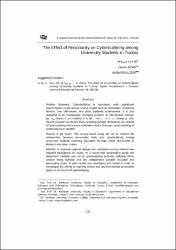| dc.contributor.author | Celik, Serkan | |
| dc.contributor.author | Atak, Hasan | |
| dc.contributor.author | Erguzen, Atilla | |
| dc.date.accessioned | 2020-06-25T17:52:39Z | |
| dc.date.available | 2020-06-25T17:52:39Z | |
| dc.date.issued | 2012 | |
| dc.identifier.citation | Çelik S., Atak H., Ergüzen A. (2012). The effect of personality on cyberbullying among university students in Turkey. Eurasian Journal of Educational Research, 12(49), 129 - 150. | en_US |
| dc.identifier.issn | 1302-597X | |
| dc.identifier.issn | 2528-8911 | |
| dc.identifier.uri | https://hdl.handle.net/20.500.12587/5201 | |
| dc.description | WOS: 000312228300007 | en_US |
| dc.description.abstract | Problem Statement: Cyberbullying is associated with significant psychological issues among young people such as depression, emotional distress, low self-esteem, and poor academic achievement. It is also regarded as an increasingly emergent problem in educational settings, putting learners' psychological health, safety, and well-being at risk. Recent research has shown that a growing number of students are victims of cyberbullying and a wider realization and a thorough understanding of cyberbullying is needed. Purpose of the Study: This survey-based study set out to explore the relationship between personality traits and cyberbullying among university students receiving education through either face-to-face or distance education modes. Methods: A sectional research design and correlation survey method was adopted throughout the study. As a causal and comparative study, the dependent variable was set as cyberbullying (actively bullying others and/or being bullied) and the independent variable included five personality types. A path model was developed and tested in order to investigate the effects of learning modes and aforementioned personality types on two levels of cyberbullying. Findings and Results: The good fit indexes belonging to the model indicated acceptable conditions and capacity for explaining the relations among the variables. Emotional instability was observed as the leading predictor of being cyberbullied with a medium effect size. On the other hand, the weakest predictor of being bullied was found to be openness to experience with a minor level negative effect size. The developed model was observed to be valid for both face-to-face and distance education learning modes. In addition, a positive and medium level relationship between bullying and being exposed to bullying was observed. Ward's hierarchical cluster analysis conducted on the points obtained from the cyberbullying scale revealed that the majority of the group rarely bullies and is rarely exposed to cyberbullying. Conclusions and Recommendations: This study contributes to the extant literature on bullying in a few conceptual areas. For instance, few research studies have examined the bullying issue in the tertiary context and through learning modes. The current investigation was limited by using a single data set to conduct all analyses. Further research is recommended to involve various variables such as cross-cultural effects on cyberbullying. | en_US |
| dc.language.iso | eng | en_US |
| dc.publisher | Ani Yayincilik | en_US |
| dc.rights | info:eu-repo/semantics/closedAccess | en_US |
| dc.subject | Cyberbullying | en_US |
| dc.subject | personality traits | en_US |
| dc.subject | distance education | en_US |
| dc.subject | path analysis | en_US |
| dc.subject | cluster analysis | en_US |
| dc.title | The Effect of Personality on Cyberbullying among University Students in Turkey | en_US |
| dc.type | article | en_US |
| dc.contributor.department | Kırıkkale Üniversitesi | en_US |
| dc.identifier.volume | 12 | en_US |
| dc.identifier.issue | 49 | en_US |
| dc.identifier.startpage | 129 | en_US |
| dc.identifier.endpage | 150 | en_US |
| dc.relation.journal | Eurasian Journal Of Educational Research | en_US |
| dc.relation.publicationcategory | Makale - Uluslararası Hakemli Dergi - Kurum Öğretim Elemanı | en_US |
















